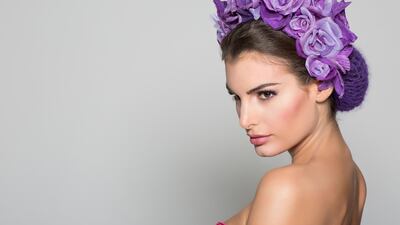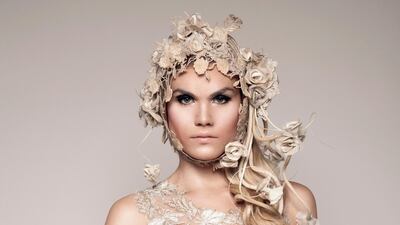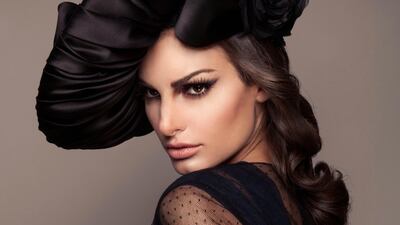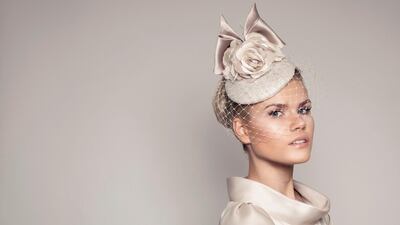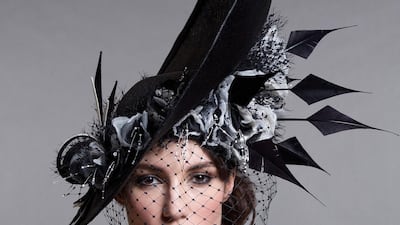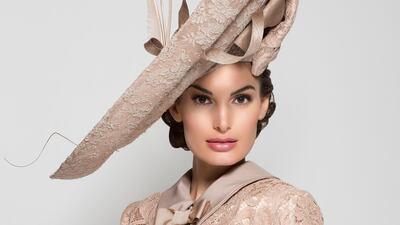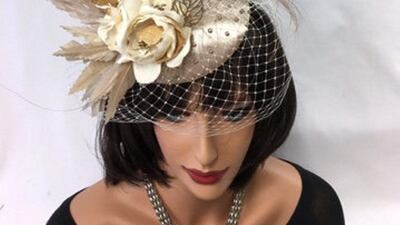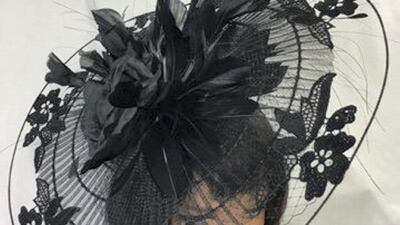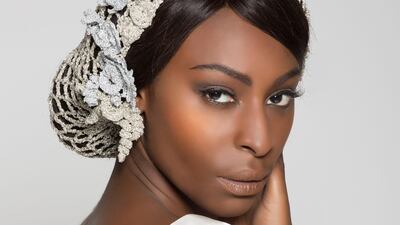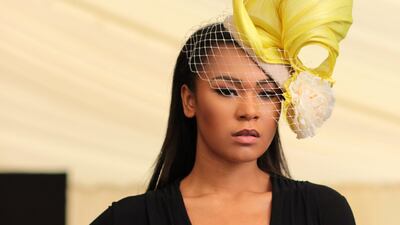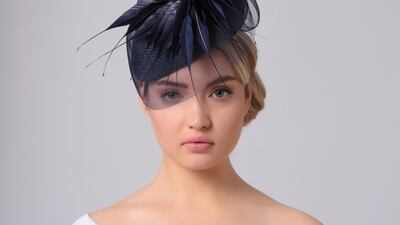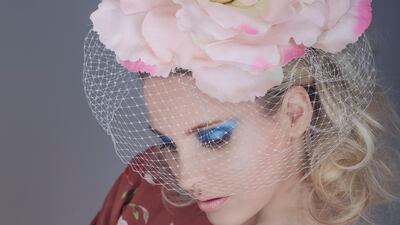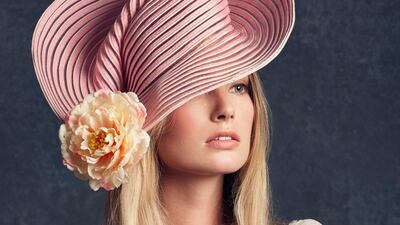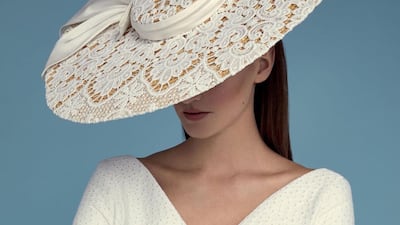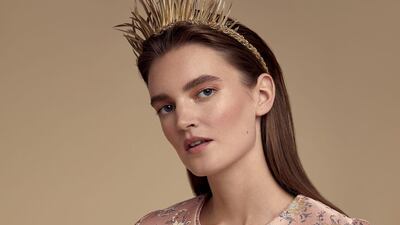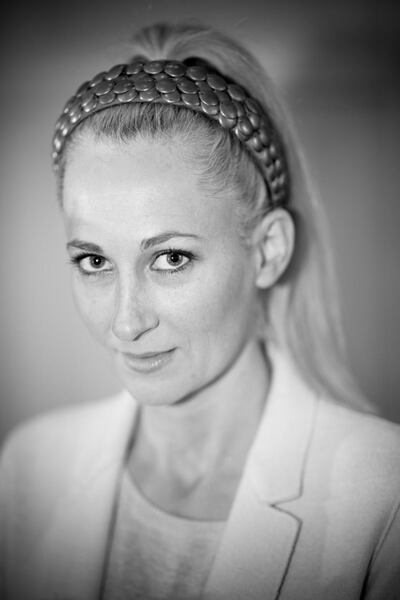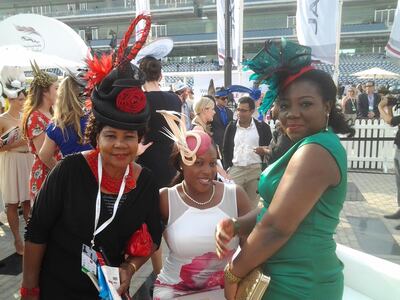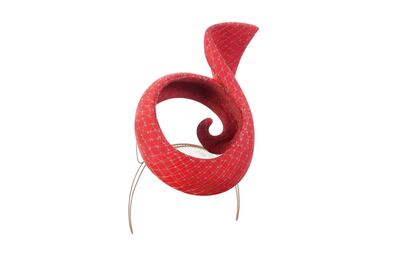When it comes to race-day hats, sumptuous fabrics, luminous ornaments, ostentatious feathers, flowers and even fruit are all par for the course.
Case in point: Princess Haya bint Al Hussein’s bespoke Philip Treacy hat with a vertical black straw design, edged with a stripe of white and trimmed with a silk rose under the raised brim, with a cluster of feathers on top, worn at the Royal Ascot races earlier this year; and Anabella Pribylova’s winning creation – a jagged wave pattern in metallic rose gold – at last year’s Dubai World Cup.
Pribylova is a milliner herself, and her hats are a regular feature at the Meydan racetrack, seen alongside the colourful creations of the hordes of other international designers who descend upon Dubai at this time of year. Horse-racing season sees milliners such as Asim-Ita Kingsley from Nigeria, Edwina Ibbotson and Lee Edmondson of Designs by Christiane, from the United Kingdom, and Australia’s Liza Georgia, displaying their wares at pop-ups and exhibitions around the emirate. Most of them are set to return for the March 31 World Cup event, joined this time around by Emily Baxendale of Emily-London, who is a milliner for the British royal family and also counts a number of celebrities as her clients. Baxendale was in Dubai last month to showcase her latest collection, which will be displayed at Harvey Nichols - Dubai at Mall of the Emirates until the end of March. She was also on-hand to offer styling advice for the upcoming race and to take bespoke orders.
Unlike the over-elaborate head baubles one has come to associate with Dubai’s racing set, a quick glance through Emily-London’s in-store and online collections reveals a cleaner, more classic aesthetic. “I’m a huge equestrian enthusiast, but often at the races, the press only zoom in on hats that are more like showpieces. These aren’t necessarily representative of the general aesthetic of the time,” says Baxendale. “I think a hat should complete an outfit, without being over-the-top gaudy. To me, having feathers and beadwork and multiple colours all together would be a big no-no. It’s all personal taste, of course, but we usually design pieces we would like to wear ourselves.”
By we, Baxendale means the team of five women in her London studio, each in charge of a different aspect of the hat-making process. Everything, from the moulding of the base to the dyeing and draping of the fabric, is done by hand, as is any crystal or beadwork. Emily-London sources its handmade wooden hat moulds from Luton, the heart of hat-making in the United Kingdom, and the only “gadget” the ladies use is a simple sewing machine. In that sense, millinery seems to have retained some of the old-school workmanship that translates into individually crafted, hand-worked pieces.
Originally conceived as protection against the elements, headwear has undergone a long and fascinating journey – from being worn by women to protect their modesty, as a sign of respect in places of worship and, of course, to make a style statement. Baxendale, who did her apprenticeship under Rachel Trevor-Morgan, milliner to Queen Elizabeth II, says that despite majoring in English and French literature, for her, the storied history and present-day evolution of hat-making held the greater lure.
The same goes for Nigerian designer Kingsley, founder of Itam by King's Signature, who is a trained architect. "I grew up watching my mum and grandmum making hats and head wraps, so it was always in my DNA. My background as an architect helps me to focus on form and visualise my creations in 3D even before I've made them, which is a helpful aid because a hat is only as good as its fit," he says. He has set up a kiosk at BurJuman mall ahead of the Dubai races, marking his sixth year here in a row.
The right fit is the result of a number of factors. To start with, a “good” hat must be attractive in its own right, and suitable for the occasion it’s being worn to. Next, it must flatter the features and personality of its wearer, both in terms of size and embellishments. The shape and colour must also match the overall ensemble, and either be in keeping with current trends, or be a timeless design, such as the pillbox.
“The Jackie Onassis pillbox is a really flattering shape – it’s flat and sits on the back of the head – and it goes perfectly with a nipped-in waist and pencil skirt. We make that style quite often for bespoke clients. If styled properly with some volume to the hair, it can look amazing,” says Baxendale. Milliners, then, are often the go-to not only to construct a hat, but also to advise people on how to style it.
"Think about what you're going to be doing at the event. Will you be meeting a lot of people? Are you going to be hugging a lot of people? If so, opt for a small or medium-sized hat," says Kingsley.
Baxendale adds that the wires, bands or clips that bind the hat to your head or hair are an important element, too, as these will hold the topper in place if you’re bending down to sit, say, or to retrieve a fallen clutch. Practicality is the number-one priority when it comes to the milliner’s trade and, to this end, the quality of materials used plays a major part. In fact, the word milliner was originally designated to the hat merchants who came from Milan, the birthplace of luxurious fabrics.
“Like many things, the amount you pay for material, generally dictates the quality of the finished product. A better-quality silk, leather or straw can make all the difference to the look of the hat,” says Pribylova.
Emily-London, which usually works with fine lace, duchess silks, rich velvets and brocades, has recently started using fur-free fur. “As many designers will attest, until recently, faux fur simply did not look luxurious enough; the quality was cheap and that reflected in the finished product. That is no longer the case, with fur-free fur looking every bit as opulent, so there’s no excuse to not wear it. Our feathers, too, are ethically sourced, natural byproducts,” says Baxendale, adding: “Our Panamas are hand-woven in Ecuador, and we work a lot with natural linens and hessians, in addition to beautiful lace and lustrous silks and velvets. A lot of thought goes into whether a hat is for a summer or winter collection, which would then impact the weight and texture of its fabric as well as the luminosity and layering of the embellishments.”
For all the thought, hard work and expense that goes into making a single hat, the accessory’s newest consumers, millennials – who come armed with both spending power and the ability to make or break a brand or trend – seem largely unimpressed with traditional headgear, or so claim the milliners. “Young ladies, these days, will have nothing to do with hats, but they are quite big on fascinators and turbans,” says Kingsley.
Accordingly, most milliners have branched out into producing wraps, turbans, bands, clips and myriad hair accessories in the hope that they’ll find favour with this discerning set of spenders. The Emily-London pop-up at Harvey Nichols, for example, has just as many bead-encrusted head bands as it does regular hat styles. The team have also designed a cross between a hat and a turban, with an elaborate twist of fabric, available in a limited-edition print.
“It’s an interesting time for hats and other headwear,” notes Baxendale. “On the one hand, you have occasions, such as horse races, where most people try to get as creative as possible with traditional shapes; and on the other, you have the artistic, quirky and unconventional designs, be it a detachable veil for a modern-day bride or an exquisite bejewelled turban that can also be styled as a scarf, both for the experimentative dresser, as well as for the modest-wear wardrobe. In the end, as a designer, you always aspire by your clients and your contemporaries and, hopefully, they by you,” she concludes.
________________
Read more
Winners shine at Dubai World Cup in both racing and fashion
A feather in the cap of milliner Harvy Santos
The five craziest things we saw at Milan Fashion Week
________________
